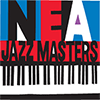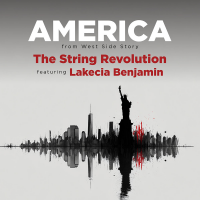Home » Jazz Musicians » John Lewis
John Lewis

The Modern Jazz Quartet managed that rarest feat of all: to make great art that pleased the serious listener as well as it did the general public. The M.J.Q., as they were known, featured vibraphone, bass, drums, and piano, and yet had the breadth of an orchestra and the intimacy of the most delicate chamber ensemble. Even when they played music written by others, it sounded as though it had been written for them, but they played mostly original compositions by musical director John Lewis, about whom too much can never be said. His was one of those quintessentially American lives a tale of someone who truly invented a life based on a love of music.
John Lewis is certainly a unique figure in American music. Born in 1920, he grew up in New Mexico, graduating from Albuquerque High School in 1937, and from the University of New Mexico in 1941 with a degree in anthropology. Before he joined the army, Lewis encountered both tenor saxophonist Lester Young and composer, bandleader, and pianist Duke Ellington. They were to be formative influences�"Young for showing how improvisation can have all the hallmarks of great composition, and Ellington in terms of how to set the music down on manuscript paper without sacrificing its spontaneity. Both these men also reveled in musical counterpoint. And throughout his life, Lewis thrived on the frisson that one good idea engendered. In fact, many of his achievements can be viewed through a prism of action and reaction. Lewis was an avid student and admirer of European music, and used it as a model from which to launch his own penchant for variations. He managed to retain the flavor of some these influences, yet created an idiom that was intrinsically American. Lewis could made a quartet sound like an orchestra, and knew how to make an orchestra swing and move on a dime like the best small jazz groups.
He collaborated with many of the prime innovators of his time, and was a major force in bringing the savant of "free" jazz, Ornette Coleman, to the fore at a time when the jazz establishment was skeptical, to say the least. Yet Lewis's own music always had a traditional feeling to it. He relied heavily on the blues and the indigenous forms of jazz, but brought them into a wide variety of progressive contexts where they always sounded fresh. Lewis remembered times past, but always created in the present tense. Like many original artists, he had an aura. On the surface a shy, gentle man, Lewis had a will of iron, yet he exuded for the most part a feeling of calm.
Read moreTags
Charlie Parker: Birth Of Bebop - Celebrating Bird At 100

by Mark Corroto
Let's face it, there is absolutely nothing new to say about the music of Charlie Parker, unless (insert joke here) you happen to be Phil Schaap. Lao Tzu's quote “The flame that burns twice as bright burns half as long" is fitting. John Coltrane was 40 when he died in 1967, Eric Dolphy 36 in 1964, and Clifford Brown died at 25 in 1956. Parker was dead at the age of thirty-five in 1955. His legend has grown larger with ...
Continue ReadingJohn Lewis @ 100 and More May Birthdays

by Marc Cohn
May birthdays this week on G&M! Some big ones (of course): the John Lewis centennial, Dave McKenna @ 90, Arthur Blythe and Carlos Ward @ 80. It's also Stevie Wonder's 70th this month, and May celebrant salutes are in the house (Theo Hill, Ronnie Foster, Mel Lewis, and Groove Holmes) doing 'Wonderful' tunes. We also celebrate the births of Jack Walrath (with one of my desert island tracks), Betty Carter, Darrell Grant, the late Wallace Roney, as well as Miles ...
Continue ReadingThe Modern Jazz Quartet: The Music Inn

by Elliott Simon
...in our desire for beauty in all things we are open, and one in our search for that little city of gold where the flute-player never wearies, and the spring never fades, and the oracle is not silent, that little city which is the house of art, and where, with all the Music of the Spheres, and the laughter of the gods, Art waits for her worshippers-Oscar Wilde In 1950, while Senator McCarthy spearheaded his anti-artistic witch hunts, ...
Continue ReadingThe Modern Jazz Quartet: European Concert

by AAJ Staff
Ironically, The Modern Jazz Quartet's European Concert album finally is released on CD for the first time just before the passing of the third member of the legendary group, reducing the survivors to one: Percy Heath, who also is a member of one of the leading family triumvirates in jazz. Listed as one of the favorite MJQ albums by many of its fans, European Concert initially was released as a double-album package documenting the group's performances throughout Scandinavia in 1960. ...
Continue ReadingJohn Lewis: Evolution II

by Craig Jolley
Together with Thelonious Monk and Tadd Dameron John Lewis defined the art composition for the bop generation. Beyond that he led a jazz ensemble for many years, acted as musical director for festivals and concerts, pioneered the fusion of European classical music with jazz, served as a music educator, sponsored young, unknown musicians in their first recordings, organized a series of recordings that presented veteran jazz musicians in unusual and favorable circumstances, and accompanied horn players and singers on piano. ...
Continue ReadingJohn Lewis: Evolution

by Mike Neely
John Lewis's solo piano release “Evolution" has the feel of a master playing for himself alone in a room in a manner that is entirely focused on the development of the music as he plays. There is a mindfulness that comes up through the pauses and spaces of his refined, emotional style. At times it seems the listener is eavesdropping on an intimate conversation between Lewis and his music.
One of the highlights of this CD is a gospel jazz ...
Continue ReadingJohn Lewis: Evolution

by Douglas Payne
Like a kindly grandfather with many adventures in his past and stories to tell, John Lewis tells the most ripping stories as a soloist. For years the musical director of the legendary Modern Jazz Quartet, Lewis has become known for his abilities to marry the bebop language with European classicism. As a musician, he's too often accused for his rigidity, formality and near refusal to swing. None of this logic prevails when he is the sole instrument.This is ...
Continue ReadingJazz Musician of the Day: John Lewis

Source:
Michael Ricci
All About Jazz is celebrating John Lewis' birthday today!
The Modern Jazz Quartet managed that rarest feat of all: to make great art that pleased the serious listener as well as it did the general public. The M.J.Q., as they were known, featured vibraphone, bass, drums, and piano, and yet had the breadth of an orchestra and the intimacy of the most delicate chamber ensemble. Even when they played music written by others, it sounded as though it had been ...
read more
Odds Against Tomorrow (1959)

Source:
JazzWax by Marc Myers
Directed by Robert Wise and produced by HarBel, Harry Belafone's production company, Odds Against Tomorrow (1959) starred Belafonte, Robert Ryan, Shelley Winters, Ed Begley, Gloria Grahame and famed dancer Carmen De Lavallade as Kitty. The score is by composer, arranger and Modern Jazz Quartet pianist John Lewis. The soundtrack orchestra included Lewis (arr,cond); Bernie Glow, Joe Wilder, John Ware and Melvyn Broiles (tp); John Clark and Tom McIntosh (tb); Al Richman, Gunther Schuller, Paul Ingram and Ray Alonge (Fr. hrns); ...
read more
Jazz Musician of the Day: John Lewis

Source:
Michael Ricci
All About Jazz is celebrating John Lewis' birthday today!
The Modern Jazz Quartet managed that rarest feat of all: to make great art that pleased the serious listener as well as it did the general public. The M.J.Q., as they were known, featured vibraphone, bass, drums, and piano, and yet had the breadth of an orchestra and the intimacy of the most delicate chamber ensemble. Even when they played music written by others, it sounded as though it had been ...
read more
Jazz Musician of the Day: John Lewis

Source:
Michael Ricci
All About Jazz is celebrating John Lewis' birthday today!
The Modern Jazz Quartet managed that rarest feat of all: to make great art that pleased the serious listener as well as it did the general public. The M.J.Q., as they were known, featured vibraphone, bass, drums, and piano, and yet had the breadth of an orchestra and the intimacy of the most delicate chamber ensemble. Even when they played music written by others, it sounded as though it had been ...
read more
Jazz Musician of the Day: John Lewis

Source:
Michael Ricci
All About Jazz is celebrating John Lewis' birthday today!
The Modern Jazz Quartet managed that rarest feat of all: to make great art that pleased the serious listener as well as it did the general public. The M.J.Q., as they were known, featured vibraphone, bass, drums, and piano, and yet had the breadth of an orchestra and the intimacy of the most delicate chamber ensemble. Even when they played music written by others, it sounded as though it had been ...
read more
Jazz Musician of the Day: John Lewis

Source:
Michael Ricci
All About Jazz is celebrating John Lewis' birthday today!
The Modern Jazz Quartet managed that rarest feat of all: to make great art that pleased the serious listener as well as it did the general public. The M.J.Q., as they were known, featured vibraphone, bass, drums, and piano, and yet had the breadth of an orchestra and the intimacy of the most delicate chamber ensemble. Even when they played music written by others, it sounded as though it had been ...
read more
Jazz Musician of the Day: John Lewis

Source:
Michael Ricci
All About Jazz is celebrating John Lewis' birthday today!
The Modern Jazz Quartet managed that rarest feat of all: to make great art that pleased the serious listener as well as it did the general public. The M.J.Q., as they were known, featured vibraphone, bass, drums, and piano, and yet had the breadth of an orchestra and the intimacy of the most delicate chamber ensemble. Even when they played music written by others, it sounded as though it had been ...
read more
Jazz Musician of the Day: John Lewis

Source:
Michael Ricci
All About Jazz is celebrating John Lewis' birthday today!
The Modern Jazz Quartet managed that rarest feat of all: to make great art that pleased the serious listener as well as it did the general public. The M.J.Q., as they were known, featured vibraphone, bass, drums, and piano, and yet had the breadth of an orchestra and the intimacy of the most delicate chamber ensemble. Even when they played music written by others, it sounded as though it had been ...
read more
Blue Engine Records Releases "The Music Of John Lewis" From The Jazz At Lincoln Center Orchestra With Wynton Marsalis Featuring Jon Batiste

Source:
All About Jazz
Available in stores, online and streaming March 24 Honoring the legacy of the Modern Jazz Quartet’s maestro, John Lewis, Blue Engine Records announces its newest release: The Music of John Lewis by the Jazz at Lincoln Center Orchestra with Wynton Marsalis featuring Jon Batiste available March 24. In 2013, when the Jazz at Lincoln Center Orchestra with Wynton Marsalis set out to celebrate the esteemed pianist and composer, they teamed up with New Orleans’ own Jon Batiste. The bandleader of ...
read more






































